If you don’t learn this one skill, your writing is doomed to fail.
Want to know what it is?
Of course you do.
That’s because the first sentence in this article made you want to know.
In the millisecond it took you to read it, you thought about how important your writing is to you. Then you thought about the possibility of failure. Your stomach sank a little bit.
You couldn’t help but read on, to see what skill you need to master to avoid it.
You’re still reading, right?
That’s the power of an effective hook in writing – and it’s the skill you need to learn to get people to read your work.
So don’t worry – you’re not doomed to failure. In this post, I’ll teach you 8 ways to write brilliant hooks, complete with examples from hook-writing masters.
Ready to rock your readers’ world in a matter of seconds?
Let’s dig in!
What is a Hook in Writing?
A hook is the first line (or couple of lines) in a written work that grabs readers’ attention and makes them want to read more.
Your hook can be your first few sentences, but hooks can also be headlines, book titles/subtitles or sales page headers.
You’ll find hooks in:
- Personal essays
- News articles
- Fiction stories
- Blog posts
- Social media posts
- Sales pages
- Email marketing
Really, any type of writing can benefit from a compelling hook.
Of course, hooks aren’t limited to writing. You can find hooks in YouTube and TikTok videos, TV and film, and even podcasts.
So what exactly makes a good hook?
Effective hooks are:
- Short: You need to grab readers’ attention within a few seconds (or less!).
- Relevant: Your hook needs to tie directly into your story, otherwise it’s confusing.
- Attention-grabbing: The nature of a “hook” is that it captures the reader’s interest enough to make them read more.
Thinking about grabbing audience attention in just a short sentence or two may sound daunting, but once you learn a few effective techniques, hook writing becomes second-nature.
So without further ado…
8 Insanely Effective Types of Hooks (+ Examples)
Lucky for you, writers have been writing hooks for centuries. So the easiest way for you to learn hook-writing is to follow in their footsteps.
Let’s look at 18 tried-and-true types of hooks for you to try your hand at.
1. The Promise Hook
A sure-fire way to hook your reader is to promise to deliver something valuable.
For example:
- “This post will teach you to vanquish writer’s block forever”
- “This 5-step method will help you write a cover letter that lands an interview every time”
- “One simple trick will 10x your social media following”
Promise hooks are super common in blog headlines, book titles and sales headers.
Let’s look at a couple of promise hooks in action:
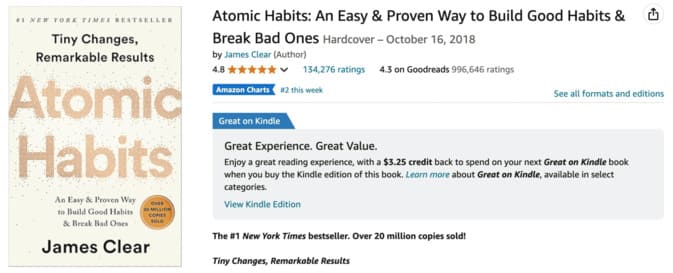
Check out the subtitle of James Clear’s book, Atomic Habits: “An Easy & Proven Way to Build Good Habits & Break Bad Ones”.
In just a few words, James is hooking the reader by promising three compelling benefits:
- “Easy” – This process won’t take a lot of effort, and anyone can do it
- “Proven” – The process is backed by some type of proof (so we know it works)
- “Build good habits & break bad ones” – A result everyone wants, but struggles to accomplish
With all those powerful promises on the cover, who wouldn’t want to read it?
Now let’s look at a promise hook from Amy Porterfield’s sales copy:
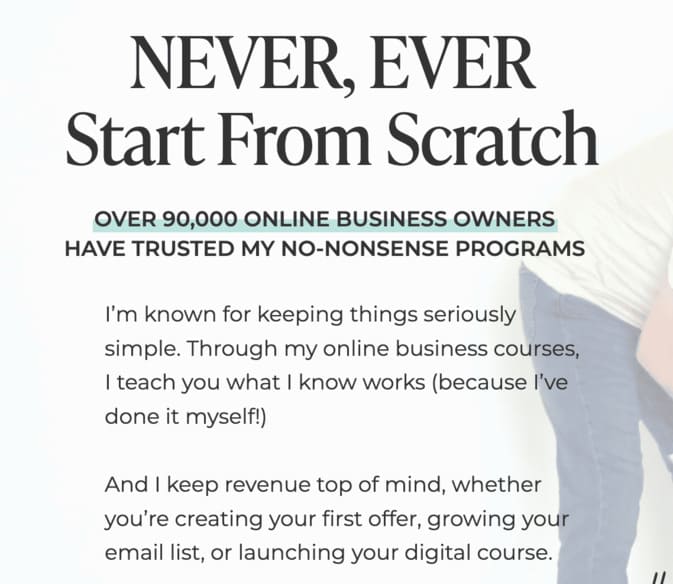
This copy contains hooks on top of hooks for new online entrepreneurs.
And they’re all promise-based.
- “Never start from scratch” – New online business owners won’t have to feel overwhelmed figuring out how to get started (A common pain point for this group).
- “Over 90k online business owners trust my programs” – A promise that the program works.
- “I’m known for keeping things seriously simple” – This program won’t be complicated.
To start writing promise hooks, ask yourself these questions:
- What pain points is your reader having and how can you solve them?
- What do your readers’ dream results look like?
- What unique benefits does your content offer?
The answers to these questions should form the basis for your promise hooks.
2. The Proof Hook
Readers want to learn and buy from people with a track record of success.
They want to know you’ve been in their shoes, faced the same barriers, and achieved results.
Otherwise, why should they listen to you?
“Proof” hooks share an achievement you’ve made – one your audience desperately wants for themselves.
When used correctly, proof hooks build immediate trust and authority.
Let’s look at an example from our CEO, Jon Morrow:
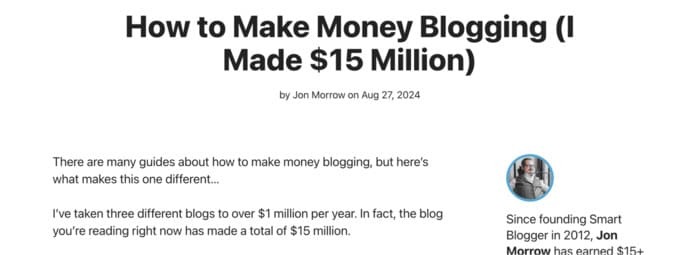
In this blog post, he’s placed proof hooks in both the headline and the introduction.
“(I Made 15 million)” establishes credibility immediately in the headline, making the reader click to learn how he did it.
He also repeats the proof hook in the intro, adding the detail that he’s taken three different blogs to over $1 million in profit per year.
If a reader’s goal is to make money blogging, it just makes sense to listen to a writer that has made millions doing it.
Here’s another awesome proof hook, from Wirecutter Magazine, which is known for their compelling proof hooks:

Now – whether you’re a bra-wearer or not – ask yourself: Who would I take advice from when it comes to buying bras?
Someone who “tests bras for a living”?
Absolutely.
To write your proof hooks, brainstorm a list of achievements you’ve made throughout your lifetime, and ask yourself which ones readers’ would want for themselves.
That’s your proof hook.
3. The Empathy Hook
People have a natural desire to be seen and understood by others.
That’s what makes an empathy hook so powerful.
Empathy hooks connect with readers’ pain points – often speaking directly to them, as if reading their mind.
Let’s look at an example from Henneke Duistermaat of Enchanting Marketing:
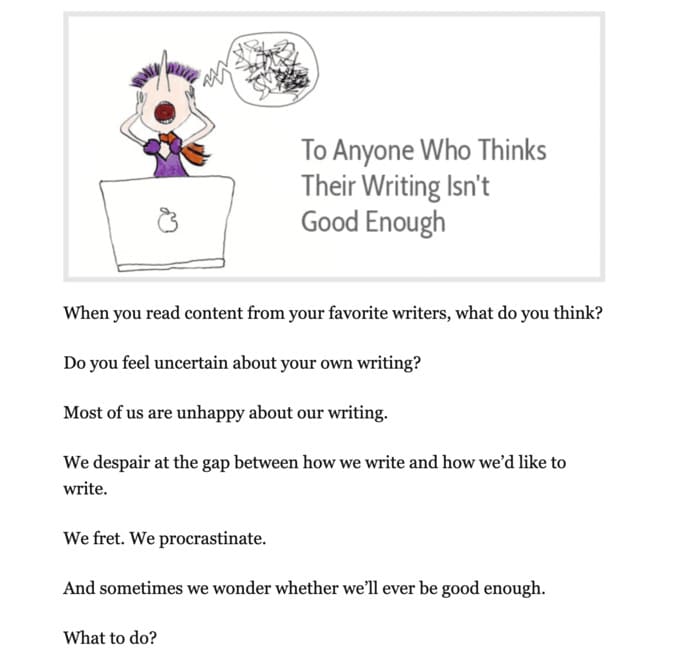
The headline is the first hook – it clarifies the target audience: “anyone who thinks their writing isn’t good enough”.
Most writers have felt this way at some point.
The intro continues with more empathy hooks, describing the emotions and habits of insecure writers:
“We despair…”
“We fret. We procrastinate.”
This language builds trust by making the reader think, she gets me!
Consider another empathy hook example – this time from an X/Twitter thread:

“Threads” on X/Twitter are a series of informative tweets – and the opening tweet must hook the reader into reading the entire thread.
Here, Dr. Nicole LePera packs a ton of empathy into one sentence, describing the common feeling of an oldest daughter protecting her family while feeling unsafe herself.
Anyone who has been in this position would feel an immediate sense of being seen and understood.
They’d want to click into the thread and read the rest of her tweets on this topic.
To write a good empathy hook, brainstorm a list of pain points, and then for each one, write down what your reader might be thinking and feeling about it. The more specific and descriptive you can be, the better!
4. The Contrarian Hook
If you want to grab your reader’s attention, disrupt the status quo.
That’s exactly what contrarian hooks do.
Contrarian hooks state an argument that goes against the grain of popular opinion.
Let’s take a look at a couple of headlines from the king of contrarian hooks, author Mark Manson.
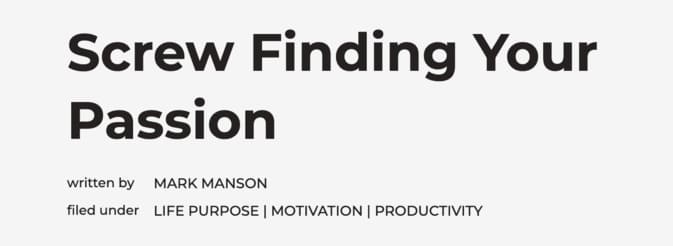
Screw finding your passion…huh?
The self-development world is saturated with content about how to find your passion. It’s one of the most popular growth-related goals of all time.
And Mark Manson says…screw it.
It makes you want to click to find out why he takes such a different view from millions of self-help writers, life coaches and therapists.
Here’s another headline from Mark:
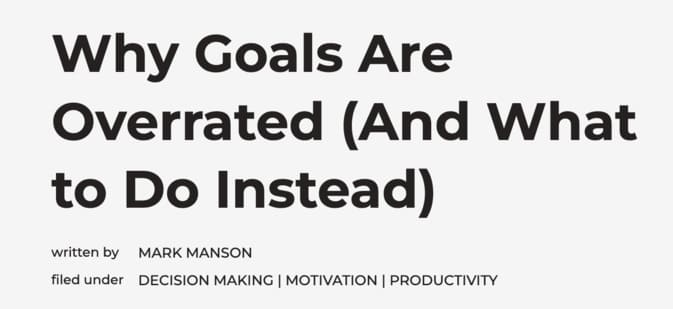
Goals…overrated? Really?
Here we have another massively popular personal-development topic – goal setting – that Mark is turning on its head.
Good contrarian hooks make readers scratch their head and say “hmm…I wonder why he feels that way”. And that curiosity is what gets them to click.
Want to write your own contrarian hook? Take a few minutes to write down any opinions you have that would be considered controversial or that fly in the face of popular opinion.
Also write down any unconventional ways you’ve accomplished a goal. Like “How being lazy helped me lose weight”.
Nothing snaps readers to attention like a little audacity.
5. The Statistic Hook
Statistic hooks work 60% of the time, every time.
While you might not get that Anchor Man reference, kicking your writing off with a staggering statistic is a super effective hook.
Statistic hooks can help establish the importance of a topic – for example, “40% of American adults are obese” would be a good way to start a persuasive essay about food disparity.
Statistic hooks can also illustrate the writer’s argument right from the get-go, like this one from a Forbes article introduction on ditching New Year’s resolutions:

Statistic hooks also sell products. Look how Slack uses a super compelling statistic hook to lend their product instant credibility:

When writing statistic hooks:
- Choose a Relevant Stat: Find a compelling statistic that directly relates to your topic and resonates with your audience’s interests or needs.
- Prioritize Surprising or Unique Data: Select data that’s either surprising, eye-opening, or confirms an unexpected insight, making it hard for readers to ignore.
- Cite a Credible Source: Use stats from reputable sources (e.g., government reports, academic studies, industry leaders) to build trust and authority.
- Keep It Concise: Present the statistic in a single, clear sentence, avoiding complex language so readers grasp its impact immediately.
6. The Massive Mistake Hook
What could be more relatable than a massive screw-up?
It happens to the best of us, and your readers appreciate and trust you when you’re transparent about it.
You’re also sparing the reader the pain of learning the hard way.
For all of these reasons, your mistakes make great writing hooks.
Let’s look an introduction from marketing CEO Kari DePhillps’ article on The Content Factory’s blog:

This hook works for a few reasons:
- It evokes curiosity – Getting sued for $8k over a crappy photo sounds extreme. How did this happen?
- It evokes fear and urgency – Readers feel the need to know how to avoid making this same costly mistake.
- It builds trust – Readers trust the writer, the agency’s CEO, because of her transparency, so they want to hear her story and advice.
Take a look another example of a mistake hook from this article in Inc Magazine, from the CEO of a wool company:

“A mistake that almost cost us our business” is a powerful hook that would have any business owner glued to the page.
To write effective mistake hooks, make a list of all the mistakes you’ve made that you think readers could learn from. Use them as hooks in your blog posts and social media.
7. The Story Hook
Humans have been telling stories for thousands of years, and our brains have become wired to crave them.
And the beginning of a story is like an open loop that the reader wants to close.
Take a look at this story hook from Jon Morrow’s blog post on Copyblogger.

Right away, Jon paints a dramatic scene.
There’s a medical issue, and a woman starts to cry.
Why is she crying? What happened?
The curiosity is overwhelming, and it’s hard to resist reading on.
Now, let’s look at a persuasive essay on the effects of oil drilling, from the Patagonia blog:
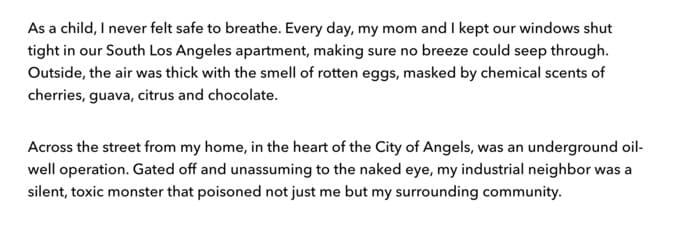
The first line is a powerful hook: “As a child, I never felt safe to breathe”.
It evokes empathy, concern and curiosity – why didn’t she feel safe breathing? You have to read on to find out.
To get started writing story hooks, think about the topic you’re writing about and if you have any personal experiences you can share. You can also tell the story of someone else’s experience.
Either way, you’ll leave your reader wanting more.
8. The Question Hook
Want to know the simplest, most effective way to write a hook?
Ask a question. (See what I did there?)
Question hooks, much like story hooks, open a loop that the reader naturally wants to close.
Questions are highly engaging because the reader has to answer them. They have to pause, and think, which means they’re sticking around.
And if your questions resonate with the reader or evoke curiosity, they’ll stick around even longer.
Check out this blog post introduction from Marie Forleo’s blog:
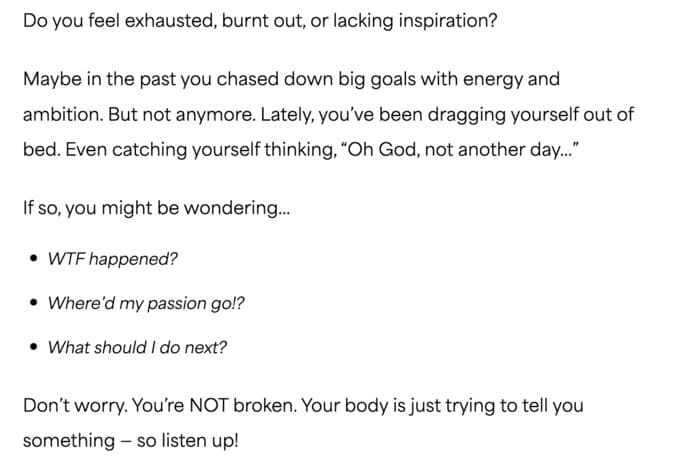
Her question hook speaks to reader pain points.
The reader mentally answers, “yeah, that’s me…and?”
It makes them curious about a possible solution.
Marie also uses empathy hooks to keep the reader glued to the page, as they keep nodding their head to her description of their thoughts and emotions.
Then she brings back more question hooks at the end of the intro, to tease solutions to the questions the reader has been asking themselves.
Your question hooks can be based on:
- Pain points – “Are you tired of feeling stressed and overwhelmed?”
- Goals – “Want to learn how to retire before you’re 50”?
- Solutions – “Ready to kick writer’s block to the curb forever?”
- Curiosity – “Want to know how one man built a 20-million dollar business without a single investor?”
It’s Your Turn to Craft The Perfect Hook
You’ve heard from the hook-writing masters.
Now it’s your turn to try your hand at writing killer hooks.
So go ahead, make your audience a promise they can’t resist.
Hit ‘em with a proof hook or a statistic hook so astounding they’ll have no choice but to keep reading.
Or suck them in with a story hook so compelling they’ll hang on your every word.
Experiment, test different ideas with your audience, and don’t be afraid to get creative.
Just remember: You’ve only got a few seconds to hook your reader.
So make it count.
The post How to Write a Hook: 7+ Bold Ways to Instantly Grab Attention appeared first on Smart Blogger.

No comments:
Post a Comment